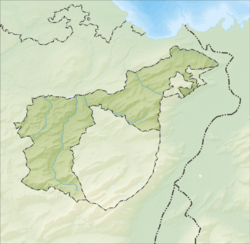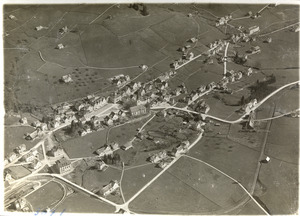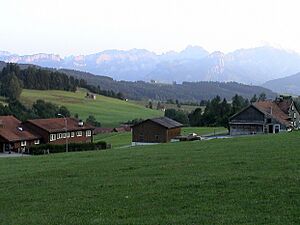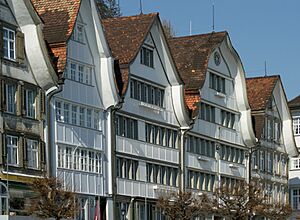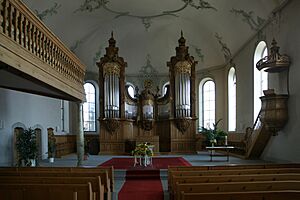Gais facts for kids
Quick facts for kids
Gais
|
||
|---|---|---|
 |
||
|
||
| Country | Switzerland | |
| Canton | Appenzell Ausserrhoden | |
| District | n.a. | |
| Area | ||
| • Total | 21.21 km2 (8.19 sq mi) | |
| Elevation
(Church)
|
915 m (3,002 ft) | |
| Population
(Dec 2020 )
|
||
| • Total | 3,066 | |
| • Density | 144.55/km2 (374.39/sq mi) | |
| Demonym(s) | German: Gaiser(in) | |
| Postal code |
9056
|
|
| Localities | Gais, Rotenwies, Rietli, Zwislen, Schachen, Stoss, Strahlholz, Steinleuten, Gäbris, Kürstein, Schwäbrig, Sommersberg, Hirschberg | |
| Surrounded by | Altstätten (SG), Appenzell (AI), Bühler (AR), Eichberg (SG), Rüte (AI), Schlatt-Haslen (AI), Trogen (AR) | |
Gais is a charming village and a municipality in the canton of Appenzell Ausserrhoden in Switzerland. It covers an area of about 21.21 square kilometers (8.19 sq mi).
In 1977, Gais won the Wakker Prize. This award is given to places that do a great job of keeping their old buildings and history safe. The village square, the Protestant church (built in 1782), the old spa hotel Neuer Ochsen (from 1796), and the Krone inn (from 1781) are all very important historical sites.
Contents
History of Gais
The village of de Geis was first mentioned in records in 1272. At that time, it was part of the Abbey of St Gall. Even then, Gais had some freedom. It had its own Ammann, who was like a local leader, and a judge.
By the 1300s, Gais was already acting like an independent community. In 1377, under its Ammann Konrad Geppensteiner, Gais joined the Swabian Cities Alliance. This was a group of cities that worked together. Later, in 1401, the town also allied with the League of God's House.
Gais was also the site of an important battle during the Appenzell Wars (1401–1429). This battle, called the Battle of Stoss Pass, happened right in Gais's territory.
Geography and Nature
Gais is located in the middle of the Appenzell region, which is known for its rolling hills, green grasslands, and forests. The village sits at about 900 meters (2,953 feet) above sea level.
The Rotbach river flows through Gais. It's a smaller river that eventually joins the Sitter River.
Gais covers an area of 21.21 square kilometers (8.19 sq mi). Almost half of this land (49.1%) is used for farming. A large part (44.3%) is covered by forests. The rest of the land is used for buildings and roads (6.2%), or it's made up of non-productive areas like rivers (0.4%).
The municipality includes the main village of Gais. It also has many smaller hamlets and scattered farmhouses.
Population and Education
Gais has a population of about 2,987 people (as of December 2008). A small part of the population, about 12.49%, are people from other countries. Over the last 10 years, the number of people living in Gais has slowly grown.
Most people in Gais (93.7%) speak German. Some also speak Serbo-Croatian (1.6%) or Italian (0.9%).
In Gais, about 73.7% of adults (aged 25–64) have completed higher education. This means they have gone to a university or a special college.
Gais has a very low unemployment rate, which means most people who want to work can find jobs. Many people work in farming (primary sector), manufacturing (secondary sector), or services like shops and hotels (tertiary sector).
Here's how the population of Gais has changed over time:
- 1667: 1,870 people
- 1850: 2,470 people
- 1900: 2,854 people
- 1950: 2,422 people
- 2000: 2,770 people
- 2005: 2,846 people
- 2007: 2,885 people
Famous People from Gais
- Albert Keller: A painter who was born in Gais on April 27, 1844.
Places to See in Gais
Gais is home to several important Swiss heritage sites. These include the main village square, the Protestant church, the old spa hotel Neuer Ochsen, and the Krone inn.
The old village was rebuilt after a big fire in 1780. It still looks much the same today, with many traditional wooden houses. These houses often have special curved gables (the triangular part of a wall under a sloping roof). The houses around the Dorfplatz (village square) and on Webergasse are the heart of the old village.
The Protestant Church was built in 1781–1782 by Hans Ulrich Haltiner. Inside, the church is decorated in a beautiful Rococo style. The detailed interior work was finished in 1782 by Andreas and Peter Anton Mosbrugger.
See also
 In Spanish: Gais (Appenzell) para niños
In Spanish: Gais (Appenzell) para niños




